Comparison of World Energy Trends and Projections: 1978 and 2017
VerifiedAdded on 2023/04/24
|7
|1512
|79
Report
AI Summary
This report assesses the accuracy of energy market projections made in the 1970s by comparing them with current data from 2017, with a focus on trends and projections for 2050. It highlights the inaccuracies of past predictions, particularly regarding non-renewable energy use, and examines revised forecasts from organizations like the EIA and IEA. The analysis reveals that the anticipated monumental shift to renewable energy sources has not yet occurred as predicted in the 1970s. The report emphasizes the impact of factors such as environmental concerns and technological advancements on energy consumption and production patterns, concluding that updated and comprehensive prediction criteria are essential for accurate future energy market assessments. Desklib provides students with access to past papers and solved assignments to aid in their studies.
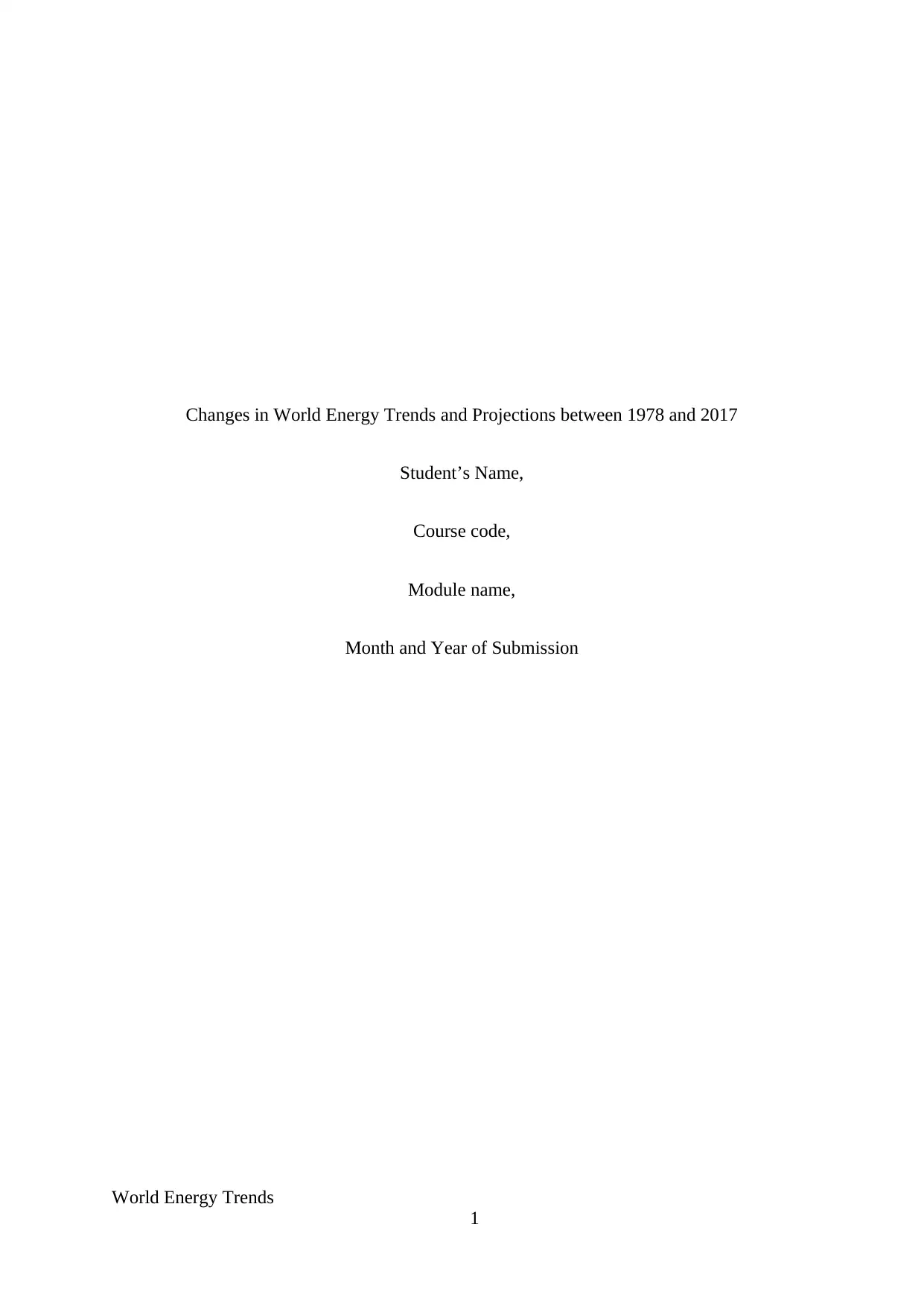
Changes in World Energy Trends and Projections between 1978 and 2017
Student’s Name,
Course code,
Module name,
Month and Year of Submission
World Energy Trends
1
Student’s Name,
Course code,
Module name,
Month and Year of Submission
World Energy Trends
1
Paraphrase This Document
Need a fresh take? Get an instant paraphrase of this document with our AI Paraphraser
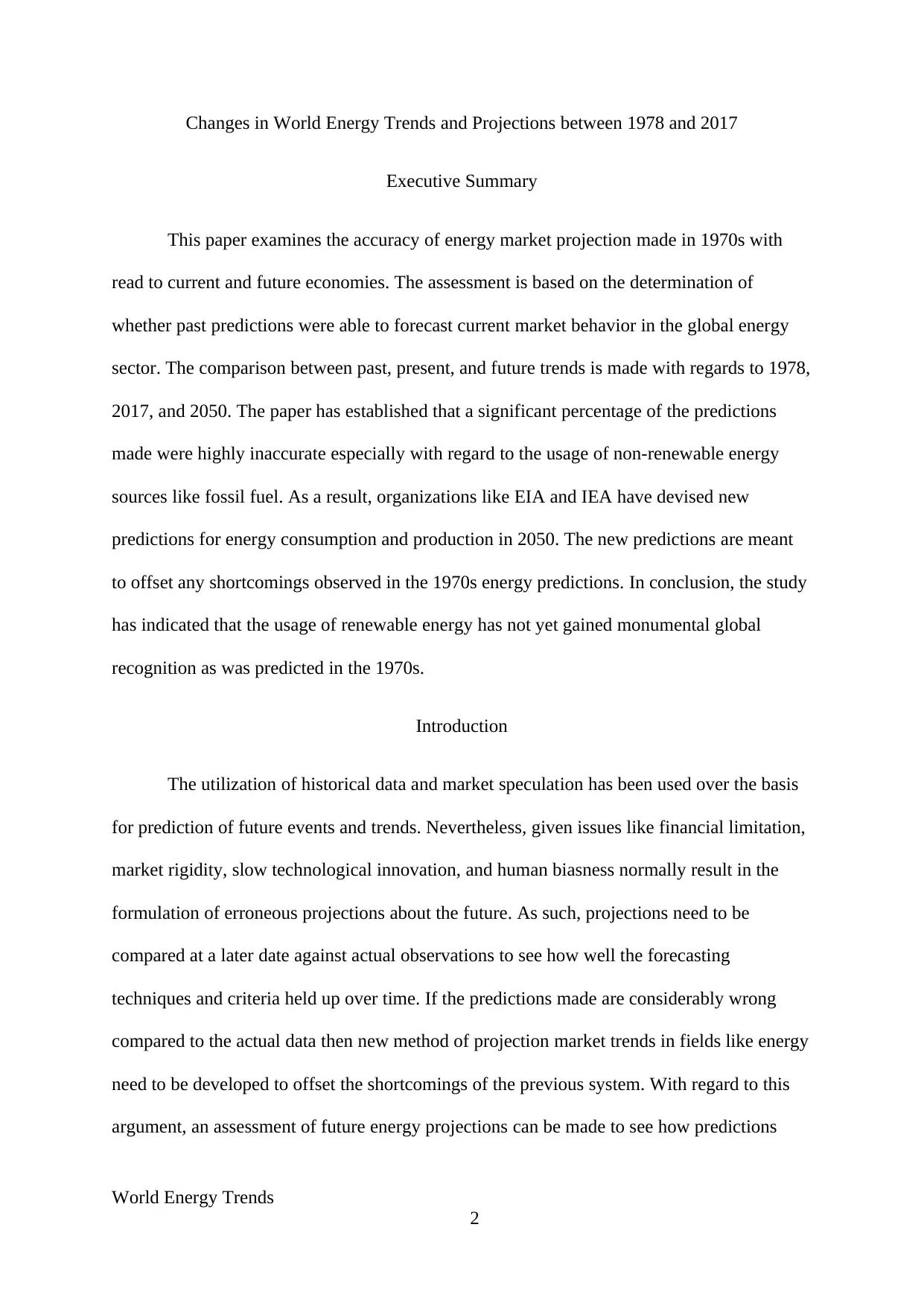
Changes in World Energy Trends and Projections between 1978 and 2017
Executive Summary
This paper examines the accuracy of energy market projection made in 1970s with
read to current and future economies. The assessment is based on the determination of
whether past predictions were able to forecast current market behavior in the global energy
sector. The comparison between past, present, and future trends is made with regards to 1978,
2017, and 2050. The paper has established that a significant percentage of the predictions
made were highly inaccurate especially with regard to the usage of non-renewable energy
sources like fossil fuel. As a result, organizations like EIA and IEA have devised new
predictions for energy consumption and production in 2050. The new predictions are meant
to offset any shortcomings observed in the 1970s energy predictions. In conclusion, the study
has indicated that the usage of renewable energy has not yet gained monumental global
recognition as was predicted in the 1970s.
Introduction
The utilization of historical data and market speculation has been used over the basis
for prediction of future events and trends. Nevertheless, given issues like financial limitation,
market rigidity, slow technological innovation, and human biasness normally result in the
formulation of erroneous projections about the future. As such, projections need to be
compared at a later date against actual observations to see how well the forecasting
techniques and criteria held up over time. If the predictions made are considerably wrong
compared to the actual data then new method of projection market trends in fields like energy
need to be developed to offset the shortcomings of the previous system. With regard to this
argument, an assessment of future energy projections can be made to see how predictions
World Energy Trends
2
Executive Summary
This paper examines the accuracy of energy market projection made in 1970s with
read to current and future economies. The assessment is based on the determination of
whether past predictions were able to forecast current market behavior in the global energy
sector. The comparison between past, present, and future trends is made with regards to 1978,
2017, and 2050. The paper has established that a significant percentage of the predictions
made were highly inaccurate especially with regard to the usage of non-renewable energy
sources like fossil fuel. As a result, organizations like EIA and IEA have devised new
predictions for energy consumption and production in 2050. The new predictions are meant
to offset any shortcomings observed in the 1970s energy predictions. In conclusion, the study
has indicated that the usage of renewable energy has not yet gained monumental global
recognition as was predicted in the 1970s.
Introduction
The utilization of historical data and market speculation has been used over the basis
for prediction of future events and trends. Nevertheless, given issues like financial limitation,
market rigidity, slow technological innovation, and human biasness normally result in the
formulation of erroneous projections about the future. As such, projections need to be
compared at a later date against actual observations to see how well the forecasting
techniques and criteria held up over time. If the predictions made are considerably wrong
compared to the actual data then new method of projection market trends in fields like energy
need to be developed to offset the shortcomings of the previous system. With regard to this
argument, an assessment of future energy projections can be made to see how predictions
World Energy Trends
2
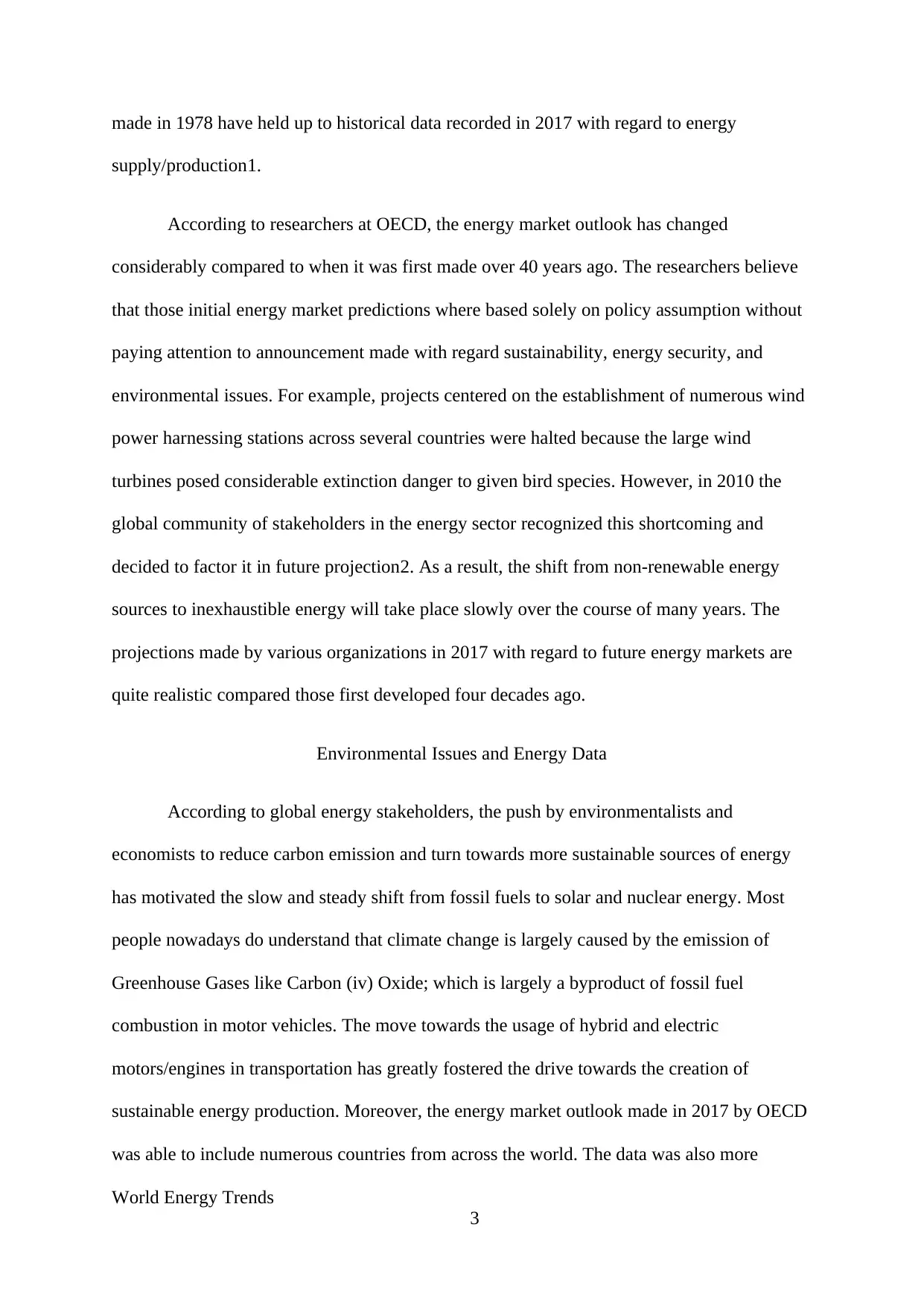
made in 1978 have held up to historical data recorded in 2017 with regard to energy
supply/production1.
According to researchers at OECD, the energy market outlook has changed
considerably compared to when it was first made over 40 years ago. The researchers believe
that those initial energy market predictions where based solely on policy assumption without
paying attention to announcement made with regard sustainability, energy security, and
environmental issues. For example, projects centered on the establishment of numerous wind
power harnessing stations across several countries were halted because the large wind
turbines posed considerable extinction danger to given bird species. However, in 2010 the
global community of stakeholders in the energy sector recognized this shortcoming and
decided to factor it in future projection2. As a result, the shift from non-renewable energy
sources to inexhaustible energy will take place slowly over the course of many years. The
projections made by various organizations in 2017 with regard to future energy markets are
quite realistic compared those first developed four decades ago.
Environmental Issues and Energy Data
According to global energy stakeholders, the push by environmentalists and
economists to reduce carbon emission and turn towards more sustainable sources of energy
has motivated the slow and steady shift from fossil fuels to solar and nuclear energy. Most
people nowadays do understand that climate change is largely caused by the emission of
Greenhouse Gases like Carbon (iv) Oxide; which is largely a byproduct of fossil fuel
combustion in motor vehicles. The move towards the usage of hybrid and electric
motors/engines in transportation has greatly fostered the drive towards the creation of
sustainable energy production. Moreover, the energy market outlook made in 2017 by OECD
was able to include numerous countries from across the world. The data was also more
World Energy Trends
3
supply/production1.
According to researchers at OECD, the energy market outlook has changed
considerably compared to when it was first made over 40 years ago. The researchers believe
that those initial energy market predictions where based solely on policy assumption without
paying attention to announcement made with regard sustainability, energy security, and
environmental issues. For example, projects centered on the establishment of numerous wind
power harnessing stations across several countries were halted because the large wind
turbines posed considerable extinction danger to given bird species. However, in 2010 the
global community of stakeholders in the energy sector recognized this shortcoming and
decided to factor it in future projection2. As a result, the shift from non-renewable energy
sources to inexhaustible energy will take place slowly over the course of many years. The
projections made by various organizations in 2017 with regard to future energy markets are
quite realistic compared those first developed four decades ago.
Environmental Issues and Energy Data
According to global energy stakeholders, the push by environmentalists and
economists to reduce carbon emission and turn towards more sustainable sources of energy
has motivated the slow and steady shift from fossil fuels to solar and nuclear energy. Most
people nowadays do understand that climate change is largely caused by the emission of
Greenhouse Gases like Carbon (iv) Oxide; which is largely a byproduct of fossil fuel
combustion in motor vehicles. The move towards the usage of hybrid and electric
motors/engines in transportation has greatly fostered the drive towards the creation of
sustainable energy production. Moreover, the energy market outlook made in 2017 by OECD
was able to include numerous countries from across the world. The data was also more
World Energy Trends
3
⊘ This is a preview!⊘
Do you want full access?
Subscribe today to unlock all pages.

Trusted by 1+ million students worldwide

comprehensive because the necessary information was collected easily and from diverse parts
of the world3.
Trends and Projections
From the ION (1978) energy results showcased in Figure 1 below, we can that energy
production was predicted to increase in favor of renewable energy sources like solar power
and nuclear fusion. From the pattern of the data in the chart, it is clear that the researchers
expected all the energy sources to follow the same trajectory they exhibited between 1950
and 1978. Nevertheless, the researchers over-estimated the extent with which inexhaustible,
hydro-power, and nuclear energy would increase by. According to the chart renewable energy
sources would experience exponential for the forecast period 1979 to 2050. While, hydro-
power and nuclear energy would showcase the same growth pattern but the increment would
slow down considerably between 2020 and 2050. On the other hand, the report seemed to
predict that the production and utilization of natural gas, crude oil, and coal would increase
by very low figures. It is clear that these three energy source are view to be the least utilized
by the year 20174.
Figure 1
From the WEO 2017 (World Energy Economy 2017) charts showcased in Figure 2
and 3 below, we see the movement of energy market between 1965 and 2050. From Figure 2
World Energy Trends
4
of the world3.
Trends and Projections
From the ION (1978) energy results showcased in Figure 1 below, we can that energy
production was predicted to increase in favor of renewable energy sources like solar power
and nuclear fusion. From the pattern of the data in the chart, it is clear that the researchers
expected all the energy sources to follow the same trajectory they exhibited between 1950
and 1978. Nevertheless, the researchers over-estimated the extent with which inexhaustible,
hydro-power, and nuclear energy would increase by. According to the chart renewable energy
sources would experience exponential for the forecast period 1979 to 2050. While, hydro-
power and nuclear energy would showcase the same growth pattern but the increment would
slow down considerably between 2020 and 2050. On the other hand, the report seemed to
predict that the production and utilization of natural gas, crude oil, and coal would increase
by very low figures. It is clear that these three energy source are view to be the least utilized
by the year 20174.
Figure 1
From the WEO 2017 (World Energy Economy 2017) charts showcased in Figure 2
and 3 below, we see the movement of energy market between 1965 and 2050. From Figure 2
World Energy Trends
4
Paraphrase This Document
Need a fresh take? Get an instant paraphrase of this document with our AI Paraphraser
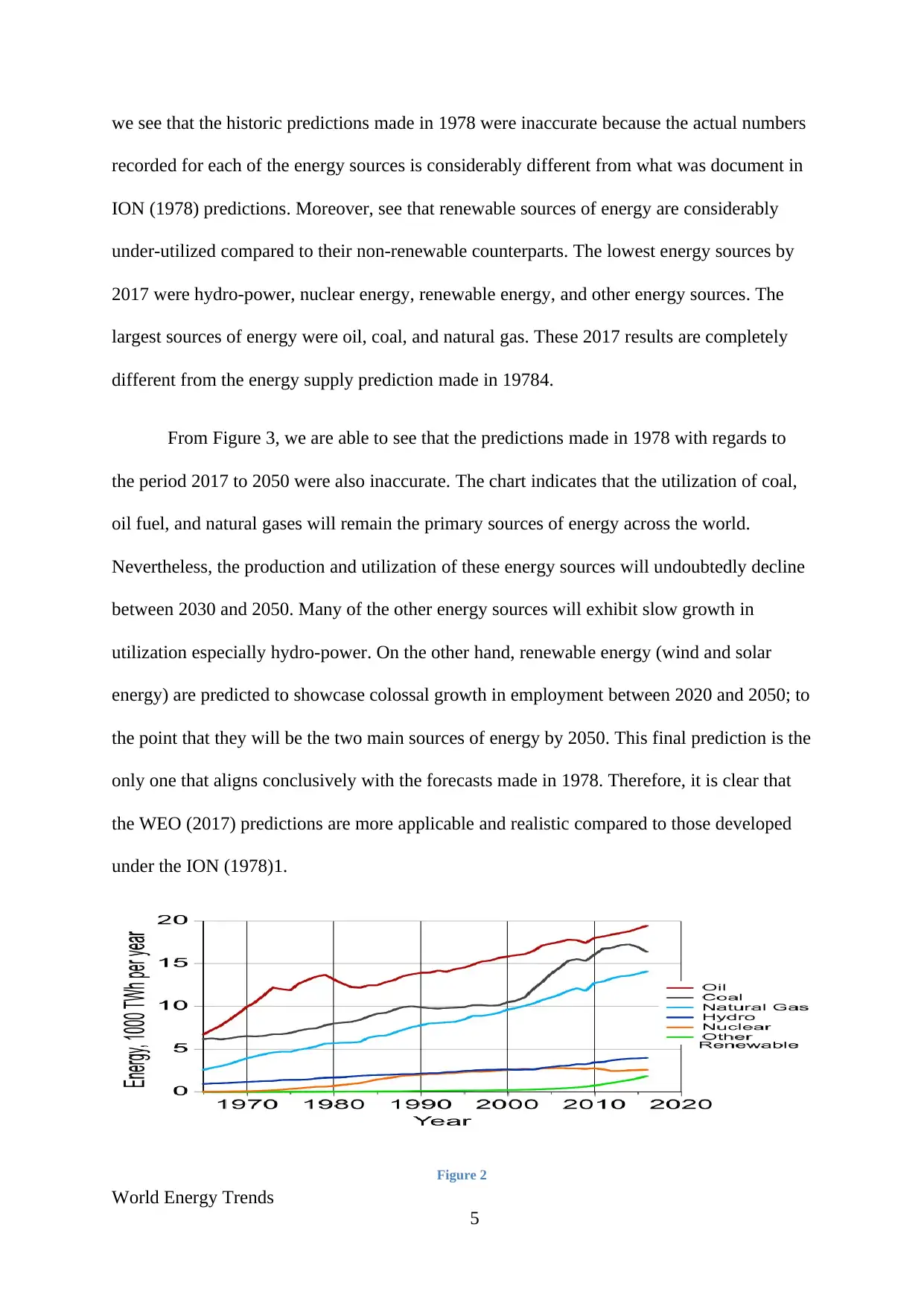
we see that the historic predictions made in 1978 were inaccurate because the actual numbers
recorded for each of the energy sources is considerably different from what was document in
ION (1978) predictions. Moreover, see that renewable sources of energy are considerably
under-utilized compared to their non-renewable counterparts. The lowest energy sources by
2017 were hydro-power, nuclear energy, renewable energy, and other energy sources. The
largest sources of energy were oil, coal, and natural gas. These 2017 results are completely
different from the energy supply prediction made in 19784.
From Figure 3, we are able to see that the predictions made in 1978 with regards to
the period 2017 to 2050 were also inaccurate. The chart indicates that the utilization of coal,
oil fuel, and natural gases will remain the primary sources of energy across the world.
Nevertheless, the production and utilization of these energy sources will undoubtedly decline
between 2030 and 2050. Many of the other energy sources will exhibit slow growth in
utilization especially hydro-power. On the other hand, renewable energy (wind and solar
energy) are predicted to showcase colossal growth in employment between 2020 and 2050; to
the point that they will be the two main sources of energy by 2050. This final prediction is the
only one that aligns conclusively with the forecasts made in 1978. Therefore, it is clear that
the WEO (2017) predictions are more applicable and realistic compared to those developed
under the ION (1978)1.
Figure 2
World Energy Trends
5
recorded for each of the energy sources is considerably different from what was document in
ION (1978) predictions. Moreover, see that renewable sources of energy are considerably
under-utilized compared to their non-renewable counterparts. The lowest energy sources by
2017 were hydro-power, nuclear energy, renewable energy, and other energy sources. The
largest sources of energy were oil, coal, and natural gas. These 2017 results are completely
different from the energy supply prediction made in 19784.
From Figure 3, we are able to see that the predictions made in 1978 with regards to
the period 2017 to 2050 were also inaccurate. The chart indicates that the utilization of coal,
oil fuel, and natural gases will remain the primary sources of energy across the world.
Nevertheless, the production and utilization of these energy sources will undoubtedly decline
between 2030 and 2050. Many of the other energy sources will exhibit slow growth in
utilization especially hydro-power. On the other hand, renewable energy (wind and solar
energy) are predicted to showcase colossal growth in employment between 2020 and 2050; to
the point that they will be the two main sources of energy by 2050. This final prediction is the
only one that aligns conclusively with the forecasts made in 1978. Therefore, it is clear that
the WEO (2017) predictions are more applicable and realistic compared to those developed
under the ION (1978)1.
Figure 2
World Energy Trends
5
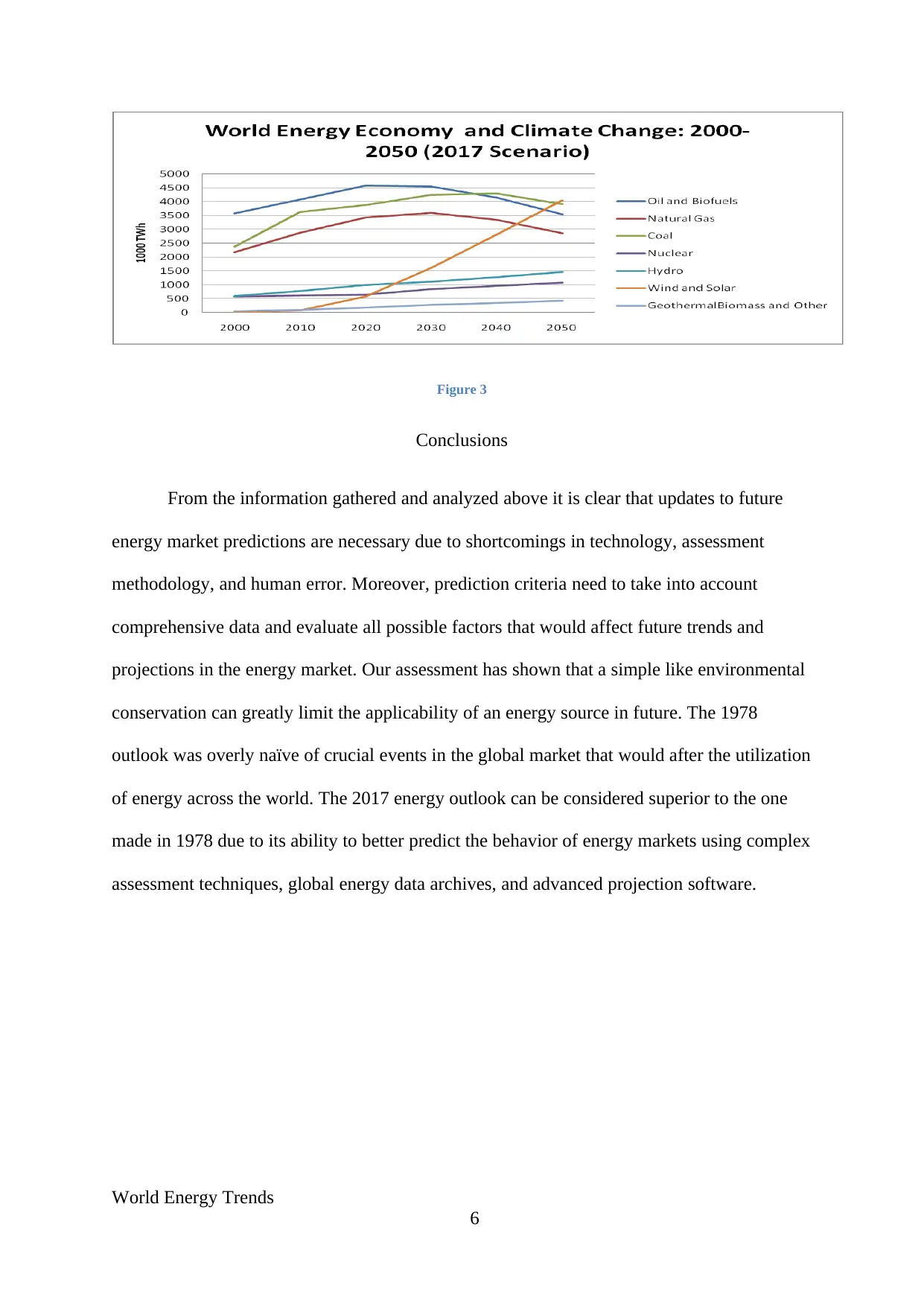
Figure 3
Conclusions
From the information gathered and analyzed above it is clear that updates to future
energy market predictions are necessary due to shortcomings in technology, assessment
methodology, and human error. Moreover, prediction criteria need to take into account
comprehensive data and evaluate all possible factors that would affect future trends and
projections in the energy market. Our assessment has shown that a simple like environmental
conservation can greatly limit the applicability of an energy source in future. The 1978
outlook was overly naïve of crucial events in the global market that would after the utilization
of energy across the world. The 2017 energy outlook can be considered superior to the one
made in 1978 due to its ability to better predict the behavior of energy markets using complex
assessment techniques, global energy data archives, and advanced projection software.
World Energy Trends
6
Conclusions
From the information gathered and analyzed above it is clear that updates to future
energy market predictions are necessary due to shortcomings in technology, assessment
methodology, and human error. Moreover, prediction criteria need to take into account
comprehensive data and evaluate all possible factors that would affect future trends and
projections in the energy market. Our assessment has shown that a simple like environmental
conservation can greatly limit the applicability of an energy source in future. The 1978
outlook was overly naïve of crucial events in the global market that would after the utilization
of energy across the world. The 2017 energy outlook can be considered superior to the one
made in 1978 due to its ability to better predict the behavior of energy markets using complex
assessment techniques, global energy data archives, and advanced projection software.
World Energy Trends
6
⊘ This is a preview!⊘
Do you want full access?
Subscribe today to unlock all pages.

Trusted by 1+ million students worldwide
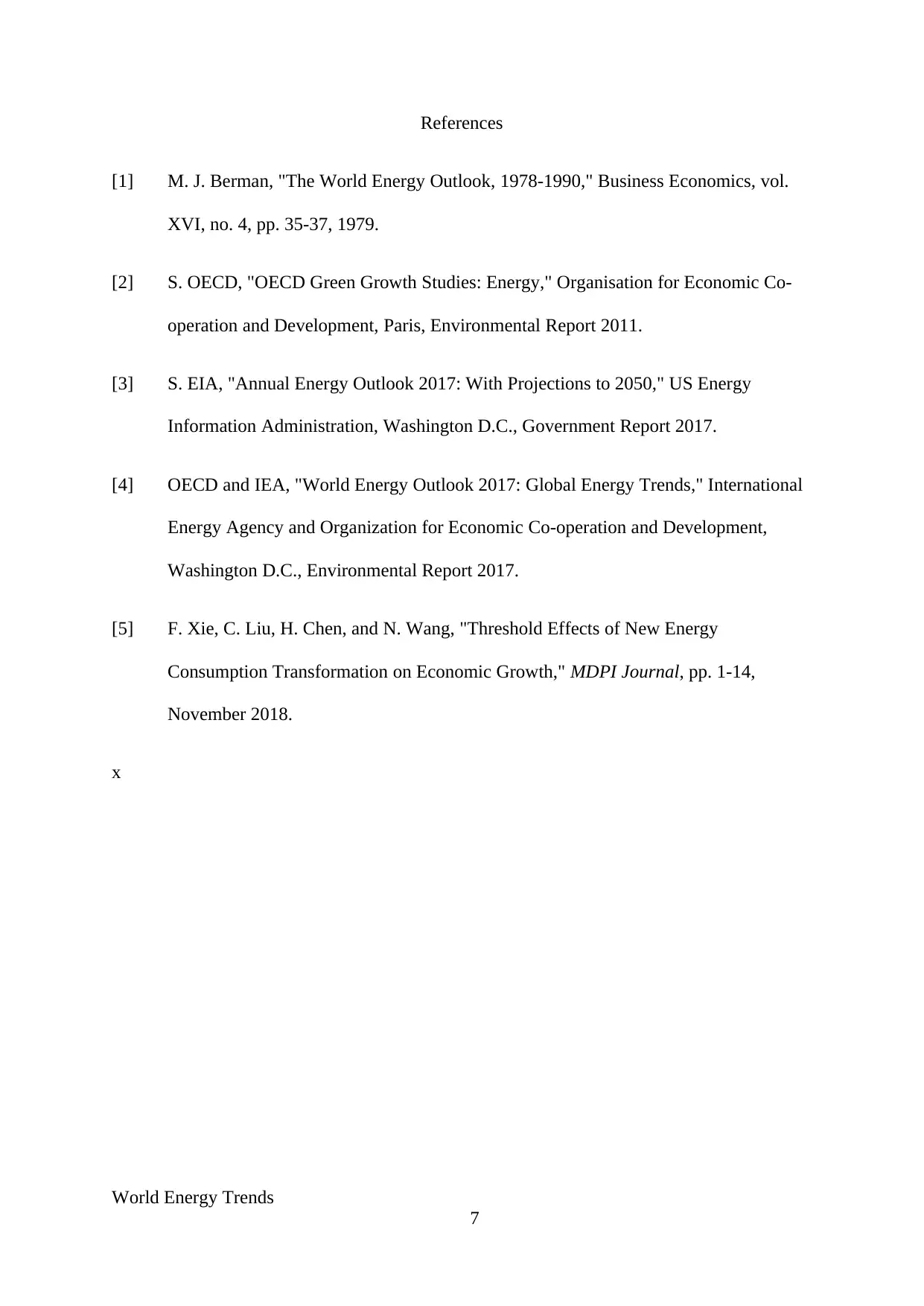
References
[1] M. J. Berman, "The World Energy Outlook, 1978-1990," Business Economics, vol.
XVI, no. 4, pp. 35-37, 1979.
[2] S. OECD, "OECD Green Growth Studies: Energy," Organisation for Economic Co-
operation and Development, Paris, Environmental Report 2011.
[3] S. EIA, "Annual Energy Outlook 2017: With Projections to 2050," US Energy
Information Administration, Washington D.C., Government Report 2017.
[4] OECD and IEA, "World Energy Outlook 2017: Global Energy Trends," International
Energy Agency and Organization for Economic Co-operation and Development,
Washington D.C., Environmental Report 2017.
[5] F. Xie, C. Liu, H. Chen, and N. Wang, "Threshold Effects of New Energy
Consumption Transformation on Economic Growth," MDPI Journal, pp. 1-14,
November 2018.
x
World Energy Trends
7
[1] M. J. Berman, "The World Energy Outlook, 1978-1990," Business Economics, vol.
XVI, no. 4, pp. 35-37, 1979.
[2] S. OECD, "OECD Green Growth Studies: Energy," Organisation for Economic Co-
operation and Development, Paris, Environmental Report 2011.
[3] S. EIA, "Annual Energy Outlook 2017: With Projections to 2050," US Energy
Information Administration, Washington D.C., Government Report 2017.
[4] OECD and IEA, "World Energy Outlook 2017: Global Energy Trends," International
Energy Agency and Organization for Economic Co-operation and Development,
Washington D.C., Environmental Report 2017.
[5] F. Xie, C. Liu, H. Chen, and N. Wang, "Threshold Effects of New Energy
Consumption Transformation on Economic Growth," MDPI Journal, pp. 1-14,
November 2018.
x
World Energy Trends
7
1 out of 7
Related Documents
Your All-in-One AI-Powered Toolkit for Academic Success.
+13062052269
info@desklib.com
Available 24*7 on WhatsApp / Email
![[object Object]](/_next/static/media/star-bottom.7253800d.svg)
Unlock your academic potential
Copyright © 2020–2025 A2Z Services. All Rights Reserved. Developed and managed by ZUCOL.





